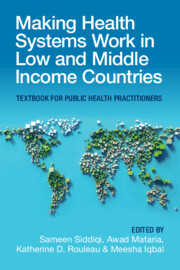17 results
Copyright page
-
- Book:
- Making Health Systems Work in Low and Middle Income Countries
- Published online:
- 08 December 2022
- Print publication:
- 29 December 2022, pp iv-iv
-
- Chapter
- Export citation
Contributors
-
- Book:
- Making Health Systems Work in Low and Middle Income Countries
- Published online:
- 08 December 2022
- Print publication:
- 29 December 2022, pp xi-xvi
-
- Chapter
- Export citation
Chapter 3 - Universal Health Coverage and Health System Strengthening
- from Section 1 - Analyzing Health Systems: Concepts, Components, Performance
-
-
- Book:
- Making Health Systems Work in Low and Middle Income Countries
- Published online:
- 08 December 2022
- Print publication:
- 29 December 2022, pp 34-50
-
- Chapter
- Export citation
Reviews
-
- Book:
- Making Health Systems Work in Low and Middle Income Countries
- Published online:
- 08 December 2022
- Print publication:
- 29 December 2022, pp ii-ii
-
- Chapter
- Export citation
Chapter 29 - Embedding People’s Voice and Ensuring Participatory Governance
- from Section 2 - Transforming Health Systems: Confronting Challenges, Seizing Opportunities
-
-
- Book:
- Making Health Systems Work in Low and Middle Income Countries
- Published online:
- 08 December 2022
- Print publication:
- 29 December 2022, pp 449-463
-
- Chapter
- Export citation
Section 1 - Analyzing Health Systems: Concepts, Components, Performance
-
- Book:
- Making Health Systems Work in Low and Middle Income Countries
- Published online:
- 08 December 2022
- Print publication:
- 29 December 2022, pp 1-224
-
- Chapter
- Export citation
Chapter 37 - Better Health Systems for Better Outcomes
- from Section 2 - Transforming Health Systems: Confronting Challenges, Seizing Opportunities
-
-
- Book:
- Making Health Systems Work in Low and Middle Income Countries
- Published online:
- 08 December 2022
- Print publication:
- 29 December 2022, pp 578-593
-
- Chapter
- Export citation
Dedication
-
- Book:
- Making Health Systems Work in Low and Middle Income Countries
- Published online:
- 08 December 2022
- Print publication:
- 29 December 2022, pp v-vi
-
- Chapter
- Export citation
Preface
-
- Book:
- Making Health Systems Work in Low and Middle Income Countries
- Published online:
- 08 December 2022
- Print publication:
- 29 December 2022, pp xvii-xx
-
- Chapter
- Export citation
Chapter 13 - Decision-Making Tools for Informed Decisions by Health Policymakers and Managers
- from Section 1 - Analyzing Health Systems: Concepts, Components, Performance
-
-
- Book:
- Making Health Systems Work in Low and Middle Income Countries
- Published online:
- 08 December 2022
- Print publication:
- 29 December 2022, pp 186-207
-
- Chapter
- Export citation
About the Editors
-
- Book:
- Making Health Systems Work in Low and Middle Income Countries
- Published online:
- 08 December 2022
- Print publication:
- 29 December 2022, pp x-x
-
- Chapter
- Export citation
Chapter 1 - Introduction to Health Systems
- from Section 1 - Analyzing Health Systems: Concepts, Components, Performance
-
-
- Book:
- Making Health Systems Work in Low and Middle Income Countries
- Published online:
- 08 December 2022
- Print publication:
- 29 December 2022, pp 1-19
-
- Chapter
- Export citation
Contents
-
- Book:
- Making Health Systems Work in Low and Middle Income Countries
- Published online:
- 08 December 2022
- Print publication:
- 29 December 2022, pp vii-ix
-
- Chapter
- Export citation
Index
-
- Book:
- Making Health Systems Work in Low and Middle Income Countries
- Published online:
- 08 December 2022
- Print publication:
- 29 December 2022, pp 594-622
-
- Chapter
- Export citation
Section 2 - Transforming Health Systems: Confronting Challenges, Seizing Opportunities
-
- Book:
- Making Health Systems Work in Low and Middle Income Countries
- Published online:
- 08 December 2022
- Print publication:
- 29 December 2022, pp 225-593
-
- Chapter
- Export citation
Chapter 4 - Health System Governance
- from Section 1 - Analyzing Health Systems: Concepts, Components, Performance
-
-
- Book:
- Making Health Systems Work in Low and Middle Income Countries
- Published online:
- 08 December 2022
- Print publication:
- 29 December 2022, pp 51-66
-
- Chapter
- Export citation

Making Health Systems Work in Low and Middle Income Countries
- Textbook for Public Health Practitioners
-
- Published online:
- 08 December 2022
- Print publication:
- 29 December 2022

